mobile View, to the German Version tap the flag


- historical region in Spain
- 10th to 13th cent. Kingdom of León
- 13th to 19th cent. part of the Kingdom of Castile-León
- today part of the Autonomous Region of Castile-León
- own name:
– Spanish: León
– Leónese: Llión
• Flags
• Meaning/Origin of the Flag
• Coat of Arms
• Meaning/Origin of the Coat of Arms
• Map of the historical Kingdoms on the Iberian Peninsula
• Numbers and Facts
• History
• Origin of the Country's Name
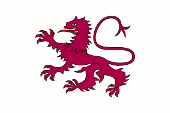
11th century,
Flag of León,
Source, by: Wikipedia (ES),
Heralder, CC BY-SA 3.0, via Wikimedia Commons



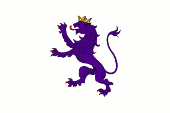
unofficial flag of the Region of León,
Source, by: Wikipedia (ES),
David Ll L, CC BY-SA 4.0, via Wikimedia Commons



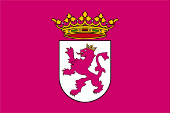
"La Purpurada",
Flag of local nationalists,
Source, by: Wikipedia (ES),
Oren neu dag, CC BY-SA 3.0, via Wikimedia Commons



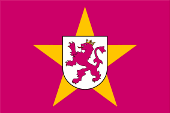
Flag of leftist local nationalists,
Source, by: Wikipedia (ES),
Oren neu dag, CC BY-SA 3.0, via Wikimedia Commons




The flag of the ancient Kingdom of León was, as was customary at the time, a flag of arms. That is, a flag that showed the image of the coat of arms of the country (actually the ruler). Consequently, the flag bunting is plain white with a red / purple lion in the center. In this early period of flags, they were actually not shaped like our flags today either. The flags were more like coats of arms, which were attached to the mast with the straight side. The lion shows red claws and a red tongue and bears a golden crown. The color of the lion is called morado (mulberry). It can look very different, from violet to purple, also reddish brown or even magenta. Likewise, the color is sometimes called red, sometimes morado, sometimes violet and sometimes purple. It is almost impossible to find a standard here. First depictions of the Lion of León can be found at the beginning of the 12th century on coins, before that a cross was used, and also on seals, whereby the shape of the lion was very different. First representations in color existed already at the beginning of the 11th century, showing a purple (lilac) lion on white (silver), at the end of the 12th century the lion appeared in violet. However, there were also natural-colored representations or even images in gold. Then, from the end of the 13th century, the lion also wore a crown to emphasize the royal power. Especially in the old Kingdom, the heraldry of the Kingdom of León and the City of León was practically inseparable. After León was dynastically merged with Castile, the heraldry of the Kingdom of León receded into the background, was not pursued and maintained. Of course, the lion appeared in coats of arms and flags of the Kingdom of Castile-León, but from the 15th century it was almost exclusively represented in red. Now it was up to the City of León to carry on the heraldic heritage. The lion in the city's coat of arms was mostly purple, rarely red, and the city's flag was also solid red. In 1977, a dispute arose because the color purple was demanded for the flag of the Provincial Council of León, because of the ancient traditions of the country. In 1982, one year before the creation of the autonomous community of Castilla y León in 1983, the heraldry was defined that for Castilla y León a purple (lilac) lion would be officially required. Nevertheless, in practice, violet is very often used for the lion. Probably the color violet has a certain connotation, because it is associated with the controversial Republic of Spain (1931-1939), whose flag showed the colors red, yellow and violet to represent León in addition to the colors of Castile. Political and cultural groups that want to preserve and promote the identity of León, or even desire the independence of the country, today usually use a flag called "La Purpurada" ("The Purple"). It is a solid purple color and shows the coat of arms of the Kingdom of León with a purple lion in the center.
Source: 1.) Wikipedia (ES), 2.) Wikipedia (ES), 3.) Wikipedia (ES), Wikipedia (DE), Volker Preuß

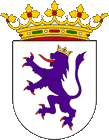
Coat of arms of León,
Source, by: Wikipedia (DE)

The coat of arms of the ancient Kingdom of León was a plain white (silvery) shield with a red and purple lion in the center. The coat of arms is a "talking coat of arms" because lion is called "Llión" in Leónese language and "León" in Spanish language. The lion shows red claws and a red tongue and bears a golden crown. The color of the lion is called morado (mulberry). It can look very different, from violet to purple, also reddish brown or even magenta. Likewise, the color is sometimes called red, sometimes morado, sometimes violet and sometimes purple. It is almost impossible to find a standard here. First depictions of the Lion of León can be found at the beginning of the 12th century on coins, before that a cross was used, and also on seals, whereby the shape of the lion was very different. First representations in color existed already at the beginning of the 11th century, showing a purple (lilac) lion on white (silver), at the end of the 12th century the lion appeared in violet. However, there were also natural-colored representations or even images in gold. Then, from the end of the 13th century, the lion also wore a crown to emphasize the royal power. Especially in the old Kingdom, the heraldry of the Kingdom of León and the City of León was practically inseparable. After León was dynastically merged with Castile, the heraldry of the Kingdom of León receded into the background, was not pursued and maintained. Of course, the lion appeared in coats of arms and flags of the Kingdom of Castile-León, but from the 15th century it was almost exclusively represented in red. Now it was up to the City of León to carry on the heraldic heritage. The lion in the city's coat of arms was mostly purple, rarely red, and the city's flag was also solid red. In 1977, a dispute arose because the color purple was demanded for the flag of the Provincial Council of León, because of the ancient traditions of the country. In 1982, one year before the creation of the autonomous community of Castilla y León in 1983, the heraldry was defined that for Castilla y León a purple (lilac) lion would be officially required. Nevertheless, in practice, violet is very often used for the lion. Probably the color violet has a certain connotation, because it is associated with the controversial Republic of Spain (1931-1939), whose flag showed the colors red, yellow and violet to represent León in addition to the colors of Castile.
Source: 1.) Wikipedia (ES), 2.) Wikipedia (ES), 3.) Wikipedia (ES), Wikipedia (DE), Volker Preuß

Map of the historical Kingdoms on the Iberian Peninsula (ca. 1220):
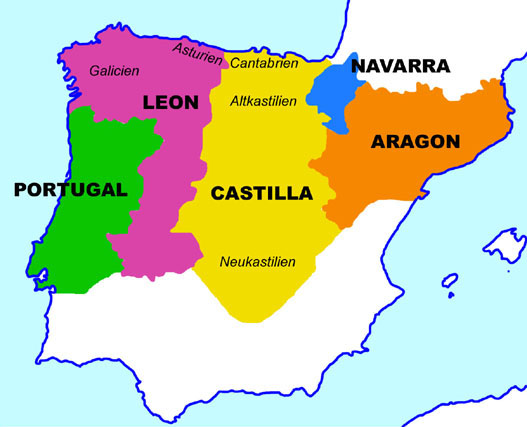
Map: Volker Preuß

Area:
in times of largest expansion ca. 19.300 square miles
Inhabitants:
in the middle ages mostly Leónese, as well as descendants of other Iberians, but even descendants of the Western Goth
Capital:
León
Language:
Leónese
Source: RetroBib Retrobibliothek, Volker Preuß

The history of León starts in principle with the Kingdom of Oviedo/Asturia. But in reality León came into being not until the heritage-division of that kingdom in the year 910.
early age · settlement of the today's Asturia by the Indo-European people of the Cantabrians (Latin: Cantabri)
ca. 600 v.Chr. · immigration of Celts, evolution of the Celtiberians
200 v. Chr. · Second Punic War, the Roman Empire acquires the possessions of Carthago in Iberia, subjugation of whole Iberia until the year 19 B.C., Roman settlement, romanization, the today’s Asturia comes to the Roman province of Hispania Tarraconensis not until the year 22 B.C.
ca. 400 · Great Transmigration (Migration Period), immigration of Alans, Suebs and Western Goth, the today’s Asturia becomes a part of the Empire of the Western Goth
711–714 · annihilation of the Empire of the Western Goth by from northern Africa coming Arabs, the Western Goth retreat to Asturia and Cantabria, the Arabs are not successful in the conquest of Asturia
716 · duke Pelayo (Pelagius), escapes from the captivity of Wititsa – the against the Arabs loyal King of the Western Goth - from Toledo to Oviedo in Asturia
718 · the Western Goth elect Pelayo to their prince
722 · battle of Covadonga, Prince Pelayo of Oviedo beats the Arabs, start of the liberation war of the Iberian nations against the Arabs (Reconquista)
739–757 · reign of Alfons I., married with Hermesinde the daughter of Pelayo, since 753 king of Oviedo (Asturia)
856 · King Ordoño I. of Oviedo (Asturia) liberates León Town from the Muslims and occupies whole Galicia
910 · death of King Alfons III. of Oviedo, division of his empire under his sons, his son Garcia I. becomes King of León, his son Ordoño II. becomes King of Galicia, his son Fruela II. inherits Asturia
914 · death of King Garcia I., his brother King Ordoño II. of Galicia inherits León
914–924 · reign of King Ordoño II. of Galicia and Oviedo (Asturia)
924 · death of King Ordoño II., the heritage comes to King Fruela II. of Oviedo (Asturia), he transfers his residence from Oviedo to León, the country is named Kingdom of León from that point in time
925 · the Counts of Burgos separate the County of Castile from Kingdom of León
931–950 · reign of King Ramiro II., a son of Ordoño II., unification of Galicia, Asturia and León under one crown (Kingdom of León), successful wars against the Arabs, expansion of the empire
950–957 · reign of King Ordono III., a son of Ramiro II., successful wars against the Arabs, expansion of the empire
957–966 · reign of King Sancho I., heritage quarrels
966–982 · reign of King Ramiro III., heritage quarrels, agitations, invasions of the Arabs
982–990 · reign of King Bermudos II., agitations, invasions of the Arabs
996 · Sultan Almansor conquers León Town and is able to hold it until his death, thereafter conquered back by King Alfons V.
999–1027 · reign of King Alfons V., restoration of the country
1028–1037 · reign of King Bermudo III., a son of Alfons V.
1037 · King Bermudo III. of León attacks the Kingdom of Castile, defeat and death of Bermudo in the battle near Rio Carrión, in this way vanish of the Pelayo dynasty, King Ferdinand of Castile inherits the Kingdom of León, in this way are Castile, León, Asturia and Galicia united under one crown (Kingdom of Castile-León).
1157 · death of King Alfons VII. of Castile, division of the heritage, León becomes an own kingdom again
1139 · Count Alfons Henry of Portugal (the son of Henry of Burgund) separates Portugal from Castile-León
1230 · León and Castile become united under one crown again by King Ferdinand III. of Castile, Kingdom of Castile-León
León is between the years 1230 and 1479 a firm component of the Kingdom of Castile-León. Isabella I. Queen of Castile-León marrys Ferdinand II., the Prince and Throne-Successor of Aragon in the year 1469. They both become crowned to the Kings of Spain in 1479 and in this way Castile-León and Aragon become united to one country. The old León becomes in this way a component of Spain and becomes reduced to an only regional importance.
1808–1813 · León is occupied by French troops
1936–1939 · Spanish civil war, Galicia fights on the side of the troops of General Franco against the socialistic central government
25th of March 1983 · Castile-León gets the statute of autonomy within Spain
Source: Wikipedia (ES),
RetroBib Retrobibliothek,
Volker Preuß

The name of the country has its roots in the Town of "León". The King of Oviedo transfered his residence into that town in 924, and from that point in time the name of the town was transmited over the whole country. The name of the town has its roots in the times of the Romans and comes from the word "Legio", the legion camp of the here stationed Legion VII. Gemina.
Source: RetroBib Retrobibliothek,
Volker Preuß


![]()














